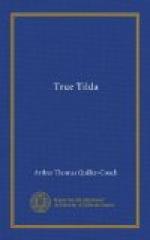The waiter turned, whisked a silver-plated salver apparently out of nowhere, and presented a paper upon it.
“Nine-and-six—and one is ten-and-six. I thank you, sir,” said the waiter, bowing low.
He was good enough to follow them to the doorway, where Mr. Jessup waved a hand to indicate a motor standing ready beside the pavement, and told the children to tumble in.
“I’ve taken your tip, you see.”
“My tip?” gasped Tilda.
“Well, you gave me the hint for it, like Sir Isaac Newton’s apple. I’ve hired the car for the afternoon; and now, if you’ll tuck yourselves in with these rugs, you two’ll have the time of your lives.”
He shut the door upon them, and mounted to a seat in front. The car was already humming and throbbing, and the hired chauffeur, climbing to a seat beside him, started her at once. They were off.
They took the road that leads northward out of Evesham, and then, turning westward, rounds the many loops and twists of Avon in a long curve. In a minute or so they were clear of the town, and the car suddenly gathered speed. Tilda caught her breath and held tight; but the pace did not seem to perturb the boy, who sat with his lips parted and his gaze fixed ahead. As for Mr. Jessup, behind the shelter of the wind-glass he was calmly preparing to sketch.
They had left the pastures behind, and were racing now through a land of orchards and market gardens, ruled out and planted with plum trees and cabbages in stiff lines that, as the car whirled past them, appeared to be revolving slowly, like the spokes of a wheel. Below, on their left, the river wandered—now close beneath them, now heading south and away, but always to be traced by its ribbon of green willows. Thus they spun past Wyre, and through Pershore—Pershore, set by the waterside, with its plum orchards, and noble tower and street of comfortable red houses—and crossed Avon at length by Eckington Bridge, under Bredon Hill. Straight ahead of them now ran a level plain dotted with poplars, and stretched—or seemed to stretch—right away to a line of heights, far and blue, which Mr. Jessup (after questioning the chauffeur) announced to be the Malverns.
At Bredon village just below, happening to pass an old woman in a red shawl, who scurried into a doorway at the toot-toot of their horn, he leant back and confided that the main drawback of this method of sketching (he had discovered) was the almost total absence of middle distance. He scarcely saw, as yet, how it could be overcome.
“But,” said he thoughtfully, “the best way, after all, may be to ignore it. When you come to consider, middle distance in landscape is more or less of a convention.”
Nevertheless Mr. Jessup frankly owned that his experiments so far dissatisfied him.
“I’ll get the first principles in time,” he promised, “and the general hang of it. Just now I’m being fed up with its limitations.”




